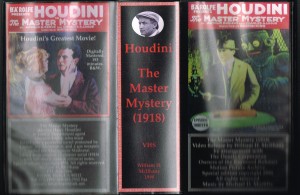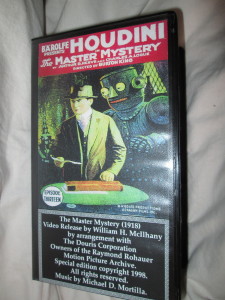
As promised, I am going to review each incomplete version of the Mastery Mystery (i.e., The Miracle Factory, Kino, McIlhany and UCLA FTVA) that I have seen and go over what pieces they contain and don’t contain. This post will focus on William H. McIlhany Special Edition Video released in 1998.


The Master Mystery (1918) Video Release by Williams H. McIlhany by arrangement with The Douris Corporation Owners of the Raymond Rohauer Motion Picture Archive runs for 193 minutes on two VHS tapes. Part 1 of 2 runs for 1 hour 56 minutes and Part 2 of 2 runs for 1 hour 18 minutes.
Edited from the original 15 chapter serial (1918) with full music score & editorial notes.
The following title cards appear at the beginning:
William H. McIlhany presents
The Master Mystery (1918) starring Harry Houdini
Released by arrangement with The Douris Corporation Owners of the Raymond Rohauer Motion Picture Archive
Digitally Mastered by James Starr
Music by Michael D. Mortilla Published by MIDI-LIFECRISIS-BMI Copyright 1998, All Rights Reserved.
Special Edition Copyright 1998 William H. McIlhany. All rights reserved.
The Master Mystery, digitally titled the Houdini Serial was copyrighted in 1918 and released in 1919 by B.A. Rolfe and Octagon Films. Houdini was forced to sue the producers to recover about $33,000 of his promised share of the profits.
What you are about to see may be the best surviving version of this 1918 serial, Rohauer edited the serial, originally 15 chapters, into approximately 11 chapters. Compared with the novel based on the original 15 chapters, the Rohauer version contains most of the story content.
The missing footage included repetitive chapter openings. We have added footage not in the Rohauer archive and hope that an even more complete video release will be possible in the future.
Raymond Rohauer Presents HARRY HOUDINI in THE MASTER MYSTERY (1919)
It added its own Episode Title Cards [EPISODE 1, 2, 3, 4, 5, 6, 7, 10, 11, 8, and 9] which had no correlation to the original 15 episodes with the exception of Episode 1 and part of Episode2. EPISODE 1 included Lockpicking a door, a Handcuff Release and Straitjacket escape. EPISODE 2 had him tied to wall with rope. While tied to wall with rope, EPISODE 3 had him using his feet to strangle a guy, get his key’s and open door [originally in Episode 2]; EPISODE 3 also included packing crate escape [originally in Episode 5] with underwater footage not in Kino, and concluded with Barbed Wire and Acid [originally in Episode 7]. EPISODE 4 started with Barbed Wire escape [originally in Epsiode 8] and ended with being bound in rope in an elevator shaft [originally in Episode 8]. EPISODE 5 had him escape the elevator [originally in Episode 9] and concluded with the Strangulation Torture [originally in Episode 9]. EPISODE 6 started with Strangulation Torture Escape [originally in Episode 10] and ended with being put in an Electric Chair [originally in Episode 6]. Episode 7 included the Electric Chair escape [originally in Episode 7]. After EPISODE 7, the following title card appeared:
The following footage from three Rohauer chapters has been arranged in what is believed to be their original order
EPISODE 10 flashed on the screen and was followed by Fishnet escape [originally in Episode 11/12]. EPISODE 11 followed with the Noose escape [originally in Episode 12/13]. After EPISODE 11, we go to EPISODE 8 where he frees himself from underground wreckage [originally in Episode 14] and then the serial concludes with EPISODE 9 [originally in Episode 15]. After the serial was over, the following title card appears:
Additional incomplete chapter footage not in the Rohauer archive.
This included some nice footage of him hanging over vat of acid and the Baker’s Dock scene where he is thrown overboard in chains.
Unfortunately, The Jail Cell with the X-ray view of the lock, Diving Suit escape, Water Tower escape, and sofa escape are missing, as is much of the story.
That said, the William H McIIhany Special Edition Version contained all of the original footage, escapes and spoken title cards that appeared on Kino. And it contained the underwater packing crate footage not on Kino, as well as the Baker’s Dock Chain Escape without the nitrate damage that appeared on Kino.
Next week, we take a closer look at the UCLA FTVA Master Mystery Contents which will fill in the rest of the story and the missing escapes.
Related:

So you’re saying this version actually has more complete footage than Kino, correct? That’s a revelation. I haven’t watched this version in ages. Going to do so asap.
Kino and Mcilhany are basically one and the same with a couple exceptions I noted.
My best guess is that by the time Kino got the the Rohauer footage, more was missing (i.e., underwater packing crate footage).
What have you been able to find about the lawsuit? Did they steal Houdini’s profits?
Houdini’s agreement with Benjamin Rolfe and Octagon Films was that he would receive fifty percent of the profits. Shortly after the picture had been released Rolfe and Houdini had a parting of the ways and the escape artist had to sue for his share of the money. In May of 1922, three years after the picture had been released, the state Supreme Court, New York County, awarded Houdini the sum of $32,795.18.
According to Kino Film Notes: Because the film was independently distributed, box-office figures and details of its national exhibition are limited…
The states’ rights distribution plan, as it often did, proved to be a problem. “By [Houdini’s] arithmetic, the picture grossed $225,000, with a net of $80,000 to half of which his contract entitled him, atop his salary,” wrote Silverman. “When the money failed to come, he decided the partners had squandered it and were ‘trying to cheat me out of my 50% profit.’ He was forced to sue Octagon for $43,000. As depositions and affidavits stacked up, the remaining partners sued one another over the sales of territorial rights…the company, having produced one picture, went bankrupt.”